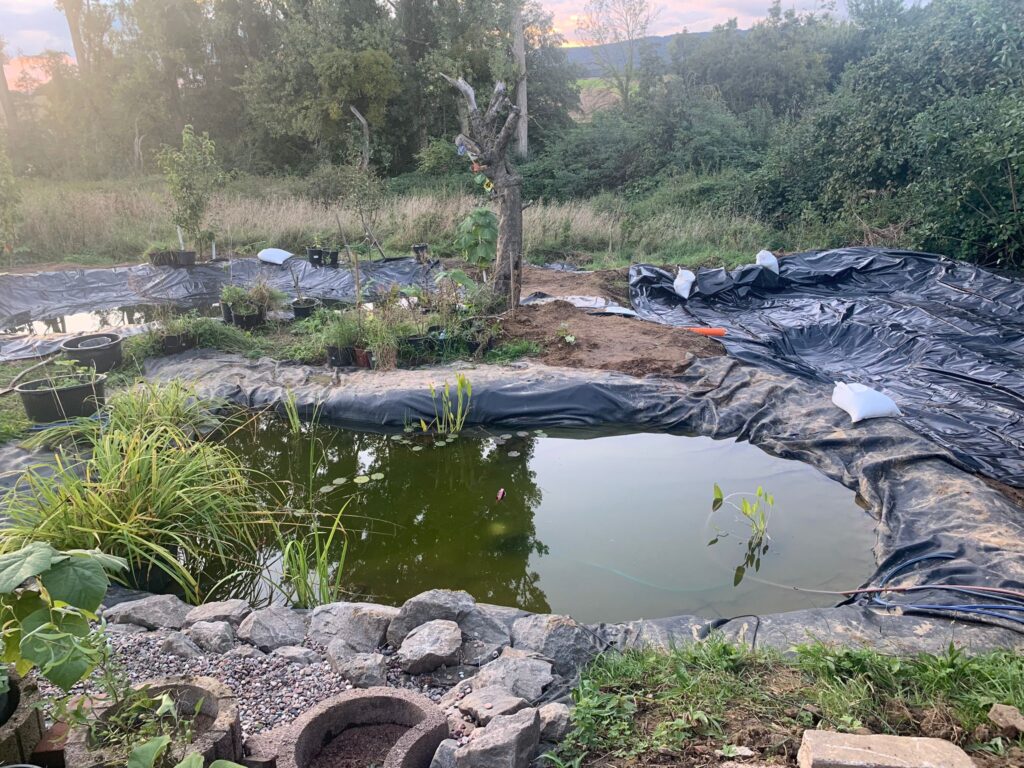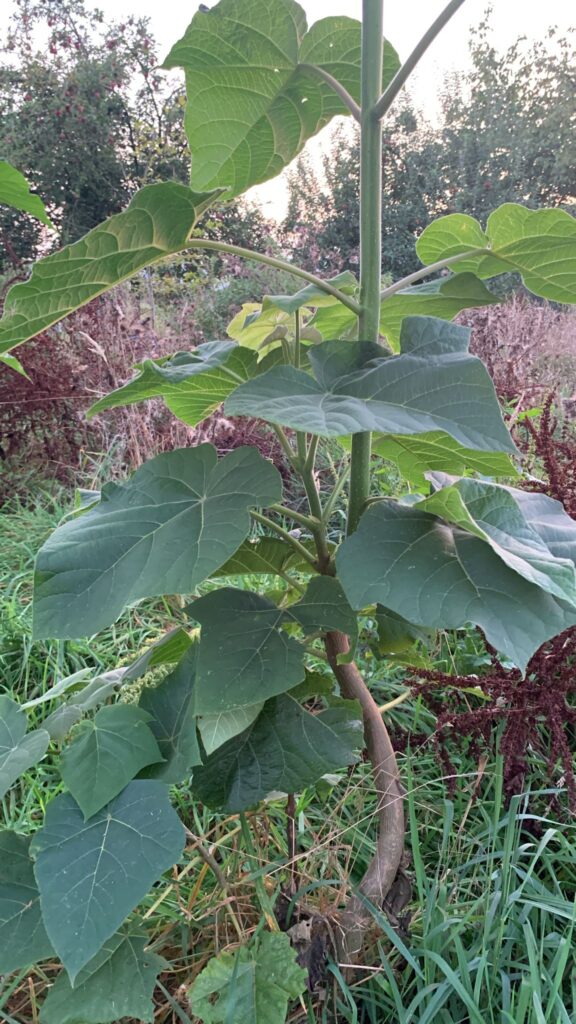Coman, September 2024 – Lower Saxony, Germany
Abstract
This technical guide is a comprehensive exploration of the key factors involved in the planning and construction of synthetic-lined water storage ponds. It draws upon the experiences from the New World Garden “Garden of Eden” Prototype Site in Lower Saxony, where methods and designs are being tested to inform larger-scale projects, including the water storage lagoons array planned for the University of Antananarivo in Madagascar. The Antananarivo “Garden of Eden Project” aims to store millions of liters of water to support the university’s freshwater needs. Additionally, these principles are under consideration as well for the Ayni Bahay project in the Philippines, where a similar approach to water storage could address community needs in water-scarce regions. We are presently looking at how to utilize the work done in 2024 by the Malagasy graduate students, can now be related and utilized as well for new sites outside of Madagascar even.

The essay emphasizes several crucial considerations, including pond levelness, liner protection, pond shape optimization, and slope design. It also addresses economic considerations, highlighting cost-saving alternatives to expensive liner protection, such as proper site preparation and material selection. Furthermore, maintenance issues are discussed, with a particular focus on the ability to repair or adjust pond liners. A case study from Lower Saxony demonstrates the flexibility and benefits of leaving liners unburied and secured with weights, as this allows for easy reshaping of the pond and increased storage capacity. This case underscores the importance of maintenance planning from the initial stages of pond construction.
By applying the lessons learned from the New World Garden “Garden of Eden” Prototype Site, future large-scale water storage projects, such as those in Madagascar and the Philippines, can be optimized for both cost-effectiveness and sustainability.
Introduction: The Role of Water Storage in Sustainable Development
Water scarcity remains one of the most pressing global challenges, particularly in developing regions, where access to clean water is a critical factor for agriculture, sanitation, and human health. With this in mind, the construction of synthetic-lined water storage ponds is increasingly recognized as an efficient and scalable solution. These ponds are designed to capture, store, and manage water, helping communities sustain agricultural productivity and meet daily water needs.

The Jacquelyn Sanders Foundation is developing the Garden of Eden Project to explore innovative methods of water storage through the construction of prototype ponds in Lower Saxony. These efforts are a precursor to larger-scale projects, such as those planned for Antananarivo, Madagascar, and Ayni Bahay in the Philippines. Through careful planning, design, and implementation, these water storage systems are expected to enhance water security in regions where freshwater is a limited resource.
Constructed Water Storage Lagoons Factors during Planning & Construction
1. Technical Considerations
Water storage pond construction is a technically demanding process. Even minor oversights during the design and excavation stages can lead to long-term inefficiencies, expensive repairs, or system failures. Key technical aspects include the pond’s levelness, liner integrity, shape optimization, and slope management.
1.1 Levelness of the Pond
Achieving a level base is crucial in ensuring the optimal functionality of a water storage pond. A level pond maximizes water storage volume and ensures even distribution of water pressure across the liner. Uneven bases can cause water to pool unevenly, leading to over-stressing the liner in certain areas, which increases the risk of punctures. As McComas (2003) points out, levelness is not only critical for operational efficiency but also for the structural longevity of the pond itself. A slight slope, however, can be beneficial for draining purposes, especially when considering how the pond will be maintained over time.
To achieve precise leveling, the use of laser levels or other accurate grading instruments during excavation is recommended. Site preparation at the New World Garden “Garden of Eden” Prototype Site involved careful attention to base leveling, with the team deploying laser-guided leveling to ensure an even base. The effectiveness of this approach has been validated, as the first ponds maintained consistent water levels without uneven pooling, a key factor in preventing liner stress and maximizing the pond’s storage potential.
1.2 Liner Protection and Installation
Synthetic liners, such as EPDM, HDPE, or PVC, are central to the pond’s water retention function, but they require protection from punctures caused by sharp objects such as rocks or roots. A meticulous site preparation process is necessary to clear the ground of debris, while a protective layer—such as sand or geotextile fabric—can significantly enhance liner durability. According to Koerner (2005), the use of geosynthetics in pond construction is now standard practice to minimize the risk of puncture and extend the lifespan of liners.
However, this protection comes with additional cost. Geotextiles are not always economically feasible, especially in regions like Madagascar, where large-scale water storage projects demand cost-effective solutions. A balance must be struck between liner protection and financial constraints. In Lower Saxony, the team at the Garden of Eden Project Prototype Site opted for a more cost-conscious approach, focusing on careful manual debris removal to protect the liner, supplemented with locally available materials where necessary.
1.3 Pond Shape Optimization
The geometry of the pond plays a significant role in water retention efficiency and liner management. While natural, organic shapes may be visually appealing, they are often less efficient in maximizing volume and can lead to unnecessary liner waste. Rectangular or square designs offer the best balance between water storage capacity and material usage, as they simplify the installation process and reduce the likelihood of folds or creases in the liner, which can lead to early deterioration.
McComas (2003) explains that rectangular ponds are ideal for maximizing volume with minimal liner material, especially in larger ponds. At the prototype site, the team experimented with both organic and geometric shapes. The findings suggested that more regular geometric shapes are advantageous not only in terms of volume but also in ensuring an easier and more secure liner installation, minimizing stress points that could lead to wear over time.
1.4 Slope Design and Erosion Control
A critical factor in pond design is the slope of the sides. Pond walls that are too steep can lead to liner folding and increased pressure, which raises the risk of damage over time. A recommended slope of 45 degrees ensures that the liner fits snugly against the walls without creating folds or tension spots. Giroud (1994) argues that a consistent slope promotes better liner placement and reduces the likelihood of erosion, which can compromise the pond’s structural integrity.
Slope design was a major consideration at the prototype site, where 45-degree sloped walls were chosen to support the liner and enhance long-term stability. Additionally, natural erosion control methods, such as planting grass along the banks, were implemented to further stabilize the soil and prevent runoff, a measure that will be replicated in the larger Antananarivo project.
2. Economic Considerations
Economic factors are pivotal when designing water storage ponds, especially for large-scale implementations like those proposed for Antananarivo. Decisions regarding materials, liner protection, and site preparation have significant cost implications.
2.1 Site Preparation Versus Liner Protection
In many cases, using geotextiles or a sand layer beneath the liner can extend the life of the pond by providing additional protection from punctures. However, these materials can significantly increase the overall cost. According to Oweis, Hachum, and Kijne (1999), proper site preparation, including thorough debris removal and compacting the soil, can be a cost-effective alternative to expensive geosynthetics.
At the Garden of Eden Project Prototype Site, the team employed a more economical approach by relying on manual labor for site preparation, carefully clearing the area of sharp objects. The success of this method underscores that a high degree of liner protection can be achieved through thorough preparation, without necessarily incurring the cost of additional materials.
2.2 Local Material Use
The use of locally sourced materials, such as earth-filled polypropylene bags for stabilizing pond edges, has proven both effective and economically viable in Lower Saxony. This method, proposed by Jacquelyn Sanders Foundation Fellow Miadana Rakotomalala (2024), is inspired by traditional earth-stabilization techniques used in Madagascar. This solution is not only cost-effective but also environmentally sustainable, reducing the need for expensive retaining structures. In Antananarivo, similar methods will be employed to stabilize pond banks and minimize erosion, reducing overall construction costs.
3. Maintenance Considerations
Proper maintenance planning is critical in ensuring the long-term functionality of water storage ponds. Liner repair, pond reshaping, and erosion control should be considered during the design and construction phases to ensure easy access for future maintenance.
3.1 Liner Repair and Replacement Options
Although synthetic liners are highly durable, they are not immune to damage. A small puncture can lead to significant water loss if not quickly addressed. For smaller punctures, repair kits are available that allow for the application of patch materials directly over the damaged area. For larger-scale repairs, bentonite clay may be introduced to naturally seal the pond. Bentonite, a swelling clay, can fill small gaps and provide a self-sealing effect, as discussed by Cook and Cowie (2014).
At the New World Garden, no liner punctures have occurred in the first three prototype ponds, a success attributed to rigorous site preparation and careful liner installation. However, the team remains prepared with repair kits and bentonite clay should issues arise, ensuring long-term resilience in the ponds.
3.2 Liner Pinning for Flexibility and Adaptation
One innovative approach developing at the New World Garden is the decision to leave the liner unburied but securely pinned with sandbags and large stones. This technique allows for easy removal and adjustment of the liner as needed, reducing the cost and complexity of future maintenance. In one instance, the team unpinned the liner, reshaped the pond, and doubled its volume with minimal labor input. By rolling back the liner, reworking the pond contours, and repositioning the liner, the storage capacity of the pond has been significantly increased.

This flexibility is a crucial consideration for larger-scale projects, such as those in Madagascar, where the ability to make adjustments as water storage needs evolve will be essential. The lessons learned from Lower Saxony demonstrate that planning for long-term maintenance from the outset provides significant advantages in terms of cost and operational flexibility.
4. Case Study: Pond Reshaping and Increased Capacity at the Garden of Eden Project Prototype Site
At the New World Garden, the team encountered a scenario that highlights the value of adaptable pond design. After constructing a rainwater receiving pond, the team realized that the walls could be reshaped to improve the pond’s capacity. By unpinning the liner and reshaping the undercarriage of the pond, the team doubled its volume with just a few hours of work. The liner was carefully rolled back, the pond walls were modified, and the liner was repositioned, effectively increasing the pond’s efficiency without the need for additional materials or extensive labor.
This case study underscores the importance of considering flexibility in liner installation. Leaving liners unburied but securely anchored offers significant benefits in terms of long-term adaptability. This approach will be especially beneficial in the planned Antananarivo project, where water storage needs may change over time. By incorporating these flexible maintenance strategies, the ponds will be able to evolve as the community’s water requirements grow.
Conclusion: Lessons for Large-Scale Water Storage Projects
The construction of synthetic-lined water storage ponds is a balance of technical precision, cost management, and long-term sustainability. Drawing from the experiences at the prototype site, this guide highlights the importance of careful planning, proper liner protection, and maintenance considerations. The methods being tested and refined in Lower Saxony will serve as a critical reference point for future projects, such as the University of Antananarivo’s water storage lagoon and the Ayni Bahay project in the Philippines.
By integrating flexibility into the construction and maintenance process, these projects can ensure that water storage systems are both resilient and adaptable to changing needs over time.
References
- Cook, M., & Cowie, J. (2014). Bentonite Sealing Solutions in Water Retention Projects. Journal of Environmental Engineering, 45(3), 233–245.
- Giroud, J. P. (1994). Design of Geomembrane Applications: Ponds, Reservoirs, and Canals. Geosynthetics International, 1(1), 3–23.
- Koerner, R. M. (2005). Designing with Geosynthetics (5th ed.). Prentice Hall.
- McComas, S. (2003). The Pond Guidebook: A Complete Guide to Site Planning, Design, and Management of Small Water Bodies. CRC Press.
- Oweis, T., Hachum, A., & Kijne, J. (1999). Water Harvesting and Supplemental Irrigation for Improved Water Use Efficiency in Dry Areas. International Water Management Institute.
- Rakotomalala, M. (2024). Practical Applications of Earth-Stabilization Techniques for Water Retention Ponds in Madagascar. Jacquelyn Sanders Foundation Research Fellowship Reports.

A one year old Paulownia growing in the grassland of the New World Garden, Lower Saxony, Germany.

Doing our part to make Madagascar Green again, by managing water for success.

